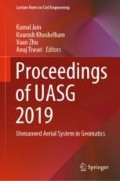Abstract
3D GIS modelling is the latest trend in Remote sensing for urban planning, utility mapping and many more applications. Mapping of an urban area using UAV (unmanned aerial vehicle) remote sensing, gives high accuracy which was not possible through traditional sensors. Urban area, which is continuously expanding, have an urgent need to find alternative energy sources to facilitate their increasing power demand. In this regard, solar energy can prove to be a vital source. In this work, high-resolution DTM (Digital Terrain Model), prepared from RGB point clouds for the Roorkee urban area using UAV survey, is used for building height extraction and 3D visualization, shadow analysis of the buildings and solar potential estimation. The CityGML based 3D city model is generated using UAV cloud dataset. CityGML, which is based on Geographic Markup language, is an open data model for the storage and it facilitates interoperability of virtual 3D city model. 3D GIS model is prepared using Computer Generated Architectural Rule Technique and various other tools such as ESRI City Engine, ArcGIS and FME software. The building height obtained from the 3D model, was validated from ground survey and the solar potential was validated from National Renewable Energy Laboratory, solar maps obtained from https://maps.nrel.gov/nsrdb-viewer/ website. The result depicted that the present status of Roorkee urban area has a strong potential to reduce the electricity load of the city via harnessing the solar energy, thus leading to a sustainable future.
Access this chapter
Tax calculation will be finalised at checkout
Purchases are for personal use only
References
ArcGIS Help 10.1 [Online]. Available: https://re-sources.arcgis.com/en/help/main/10.1/index.html#/Modeling_solar_radia-tion/009z000000t9000000/. Accessed: 08 Aug 2019
Brenner C (2000) Towards fully automated 3D city model generation. Autom Extr Man-Made Objects from Aer Sp Images, 85–92
Dubey SR (2015) Energy crisis in India: a commentary on India’s electricity sector. Partridge Publishing India
Gross H, Thoennessen U, Hansen W (2005) 3D-modeling of urban structures. Evaluation XXXVI:137–142
Guo J, Sun B, Qin Z et al (2017) A study of plot ratio/building height restrictions in high density cities using 3D spatial analysis technology: a case in Hong Kong. Habitat Int 65:13–31. https://doi.org/10.1016/j.habitatint.2017.04.012
Kolbe TH (2008) Representing and exchanging 3D city models with CityGML. 3D Geo-Inform Sci 15–31. https://doi.org/10.1007/978-3-540-87395-2_2
Peronato G, Rey E, Andersen M (2018) 3D model discretization in assessing urban solar potential: the effect of grid spacing on predicted solar irradiation. Sol Energy 176:334–349. https://doi.org/10.1016/j.solener.2018.10.011
Salleh S, Ujang U (2018) Topological information extraction from buildings in CityGML topological information extraction from buildings in CityGML
Shrivastava V, Jaiswal A, Thakur PK et al (2018) Application of GIS for the design of potable water distribution system in IIRS. ISPRS Ann Photogram Rem Sens Spat Inf Sci 4:87–94. https://doi.org/10.5194/isprs-annals-IV-5-87-2018
Waibel C, Evins R, Carmeliet J (2017) Efficient time-resolved 3D solar potential modelling. Sol Energy 158:960–976. https://doi.org/10.1016/j.solener.2017.10.054
Yigitcanlar T, Kamruzzaman M, Foth M et al (2019) Can cities become smart without being sustainable? A systematic review of the literature. Sustain Cities Soc 45:348–365. https://doi.org/10.1016/j.scs.2018.11.033
Acknowledgements
We would like to acknowledge Prof. Kamal Jain, Department of Civil engineering, IIT Roorkee to provide us the UAV dataset for this study.
Author information
Authors and Affiliations
Corresponding author
Editor information
Editors and Affiliations
Rights and permissions
Copyright information
© 2020 Springer Nature Switzerland AG
About this paper
Cite this paper
Harikesh, Singh, S., Shrivastava, V., Sharma, V. (2020). CityGML Based 3D Modeling of Urban Area Using UAV Dataset for Estimation of Solar Potential. In: Jain, K., Khoshelham, K., Zhu, X., Tiwari, A. (eds) Proceedings of UASG 2019. UASG 2019. Lecture Notes in Civil Engineering, vol 51. Springer, Cham. https://doi.org/10.1007/978-3-030-37393-1_30
Download citation
DOI: https://doi.org/10.1007/978-3-030-37393-1_30
Published:
Publisher Name: Springer, Cham
Print ISBN: 978-3-030-37392-4
Online ISBN: 978-3-030-37393-1
eBook Packages: EngineeringEngineering (R0)

